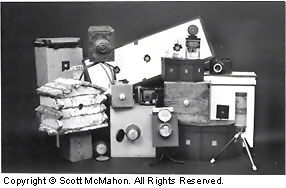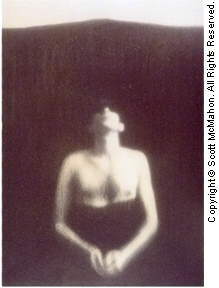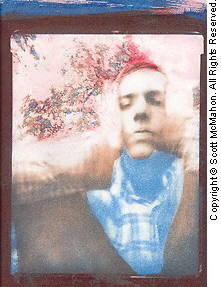
The camera was not something that man created from scratch. Instead, it occurred naturally in the world, ultimately made portable by man and enhanced with a multitude of functions. The camera obscura (literally, a “dark room,”) the earliest type of camera, was probably first mentioned by Chinese philosophers describing pinhole optics. Greek astronomers used this phenomenon to observe eclipses. They described how light rays passing through a tiny opening or small gaps in a tree’s dense foliage projected an image of the sun on the ground below.
During the Renaissance the camera obscura was used as a drawing aid. Images received through a small hole were projected on an opposite surface; artists traced the outlines of what they saw from inside the camera obscura to give the illusion of depth and perspective to their drawings and paintings. An upside down and reversed projection of the outside world in full color could be viewed. This is the essence of photography: a celebration of light.
The shadows and projections of the camera obscura have been observed and studied for centuries. The preservation of these transient impressions came much later with the invention of photography, announced in 1839. With this new ability to capture light and time, pinhole cameras (portable versions of the camera obscura) were employed. One could record what was projected inside this lightproof chamber with remarkable detail. As camera technology progressed, this primitive tool for creating photographic images was deemed archaic and the image-forming pinhole was lost.
Around the turn of the century a resurgence of pinhole images came about with the Pictorialist movement. In this movement sharpness was not as important as the atmospheric way in which the pinhole rendered reality. In recent times photographers and artists alike have explored pinhole imagery. Viewing an image from inside the camera can change the way you look at the world around you, as well as demystify the way in which photography works, breaking down technological barriers.

The first-hand optical image produced by a pinhole camera creates something that is unfiltered and undistorted. The way in which light travels directly to the film surface is much like our vision and how we perceive things. Stepping back from the technology and utilizing the basic principles of photography can often produce more intimate and meditative imagery. The truth of the subject is delineated through the characteristic long exposure of the pinhole camera. This idea is clearly demonstrated when photographing people. A person’s likeness, expression, and emotion records differently during a pinhole exposure of several seconds to several minutes than in that of an instantaneous snapshot. When sitting through a lengthy exposure the tendency is to concentrate on the body’s movement (or lack of movement). Through the duration of the exposure even the slightest movement caused by breathing is recorded, and focus and control of the body becomes important. While photographing the landscape with a long exposure the passage of time is preserved in a static image. Things visible and perhaps invisible at that time make their way onto the film. The lack of a viewfinder reinforces the elements of chance and intuition and plays an important role in the mystical properties of pinhole imaging.
The pinhole camera itself can be as important as the image that it produces, whether it’s a finely crafted wooden box or constructed out of cardboard and held together with tape. The camera is often designed and built with a specific conceptual idea in mind that becomes part of the photographic piece.
Eric Renner of New Mexico (and founder of Pinhole Resource) made a pinhole camera from a plaster cast of his face and placed the pinholes in the eyes. The series of self- portraits reflected the idea that his face and mind became the camera. A more literal approach comes from Thomas Bachler of West Germany in a series of photographs entitled: “The Third Eye”. Using small strips of unexposed 35mm film that he placed in his mouth, Bachler used his lips as the aperture, exposing images of him standing in front of a mirror. His mouth became the camera and his lips the pinhole. Paolo Gioli of Italy transforms buttons, snaps and even seashells into pinhole cameras. With the idea that every object is a container of life, he photographs the natural existence of things. Some other notable makeshift cameras include salt and peppershakers, washing machines, Volkswagen vans, birdhouses and even toilets. Pinhole camera possibilities are truly endless.
Whether of conventional or unconventional design, the pinhole camera is a light-gathering instrument of age-old technology. Returning to the roots of photography eliminates mechanical attachment and brings us closer to the medium. While still presenting some mystery, the pinhole records the image in its purest state without interference. Through the pinhole eye the ability to define space and reality brings forth the opportunity to capture images of dreams and imagination.
Making a Pinhole Camera

Pinhole cameras can be as large a room or as small as matchboxes. Virtually any light-tight container can be turned into a camera. To start, you need something to serve as your camera, a sewing needle (No. 9 or No. 10), brass shim stock or thin aluminum (throw away cookware works great), #400 sandpaper, black tape, and a magnifying glass.
To make the pinhole, gently push the needle through the piece of metal – you should have cardboard underneath so the needle has a surface to enter. Using circular motions, sand down the burr that was created by the needle. Push the needle through the other side and sand down that burr. Then, twirl the piece of metal on the needle to ensure a nice round hole. Finally, check the pinhole under the magnifying glass to make sure it is free from any debris. You should have a pre-existing hole in your camera about ½” square – tape your pinhole to the inside of this opening. Make sure the inside of your camera is painted black and check it for any light leaks. Use a piece of black tape to cover the pinhole – this will act as your shutter.
Finally, load your camera with film or paper and you are ready to take a picture. Exposure times range from several seconds to several minutes depending on the size of the camera and pinhole. If you care to find the f/stop of your camera to determine exposure times refer to Eric Renner’s book Pinhole Photography – Rediscovering a Historic Technique. If you are into serendipity use the trial and error method to come up with an accurate exposure.
By Scott McMahon

Leave a Reply